A Digital Journey Through ACE24

By Kevin Westerling,
@KevinOnWater
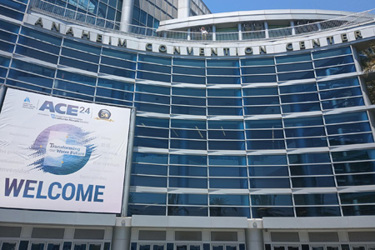
With more than 10,500 attendees at ACE24, the American Water Works Association’s Annual Conference and Exposition is getting back on track to (almost) pre-COVID levels. Held in Anaheim, CA from June 10-13, it was good to see the aisles full again.
Besides the obvious, the uptick in activity could be attributed to the hunt for solutions in response to current water industry concerns, including regulatory mandates, labor shortages, failing infrastructure, inadequate funding, and problematic water pollutants.
Many water suppliers are contending with a number of those issues — in addition to others — draining their resources and requiring them to do more with less. This is where digital solutions become so helpful, even necessary.
What follows is a roundup of the digital technologies from the ACE show floor that caught my attention, and seemed to garner excitement among attendees, for their ability to ease the operational burden of dealing with particular industry challenges.
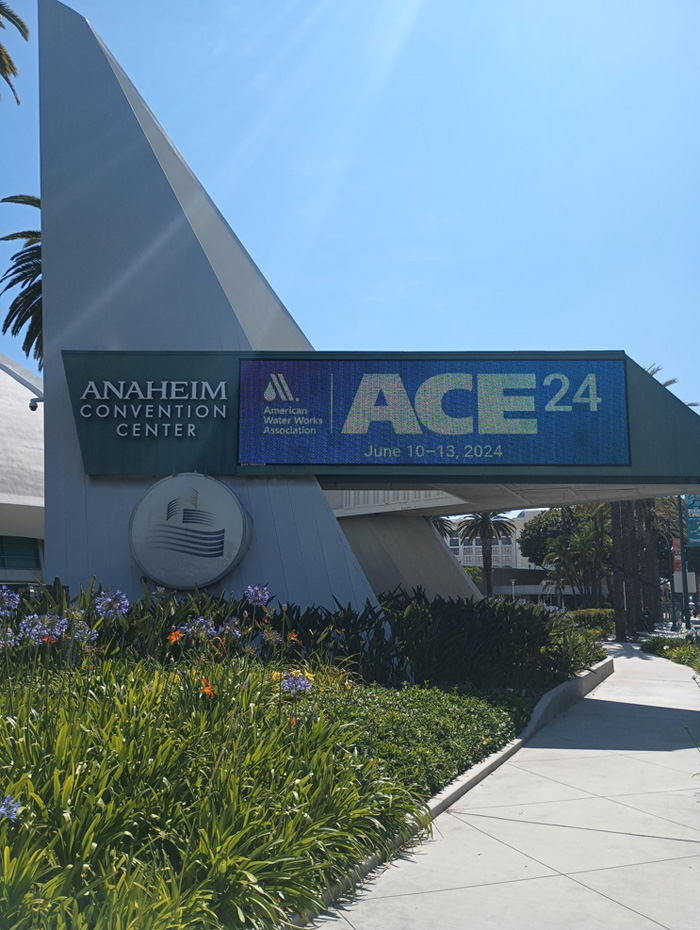
Let the journey begin…
LCRR Requirements: Finding Lead Service Lines
The Lead and Copper Rule Revisions, which kicks in on Oct. 16, 2024, requires that all utilities must create an inventory of lead service lines (LSLs) for their entire service area. Some utilities have good records, some don’t; but the EPA must have confidence in the reporting, so the means of obtaining the data is important. Companies like 120Water (check out their Water Online LCRR e-book), BlueConduit, Trinnex, and VODA.ai all provide digital tools to find lead pipes and achieve compliance, yet each offers distinct characteristics and capabilities.
Because each company’s value proposition is far too robust and nuanced to do them justice here, evaluate their ‘elevator pitch’ below, and click the links for a deeper dive.
“120Water is a unique, comprehensive solution that automates and standardizes the entire program lifecycle while giving program managers full control.
“Centralize key project data, report to relevant stakeholders, send communications to your customers and manage your programs efficiently and confidently with the 120Water software platform.” Learn more.
“BlueConduit delivers rigorously designed, predictive and decision modeling tools that empower water system leaders to make informed decisions on behalf of the communities they serve.
“Channel the power of locally tailored statistical models to validate the lack of lead in your water system, prioritizing compliance efficiency while limiting costs and public disruption.” Learn more.
“Trinnex helps infrastructure leaders advance the digital journey through proven processes, software tools, and partnership.
“With leadCAST, you’ll have everything related to your lead service line replacement program in one place. Access and share at your desk, on the go, and with the community.” Learn more.
“VODA.ai has been helping utilities by performing AI-based analyses since 2017. We’ve worked in 23 states, 5 countries and analyzed over 1M miles of pipe.
“Stop relying on the installation year and use Machine Learning to find out where lead pipes are located. Make better planning decisions and minimize health risks in your community. VODA.ai LeadFinder works for public and private laterals.” Learn more.
More Of ‘What’s In The Ground?’
What I learned from talking to some of the leaders of the companies above, including 120Water CEO Megan Glover, BlueConduit CEO Lorne Groe, and VODA.ai CEO George Demosthenous, is that the same technologies, systems, and skill sets used to find lead pipes can and are being leveraged for the location and analysis of other underground assets. Whether it’s through software programs, machine learning, AI, or the human touch that creates and informs the technology (and runs the business), it can most often be used for other things. For instance, and importantly, for finding water mains that are leaking and/or will potentially fail.
All of the above do this in one way or another (again, I encourage you to explore their sites), but one other company worth mentioning for their underground surveys is ASTERRA. They have a novel method of seeing below the surface, doing so from space — via satellites. This technique does not allow for spotting LSLs, but it does see where the water is. It can thus help with water scarcity and distribution issues, on both a large and small scale, with the ability to locate leaks that lead to non-revenue water and main breaks. They can also help to assess, maintain, and manage wastewater conveyance.
Overall Operational Oversights
Meanwhile, back at the plant…
The focus of the utility manager includes pipeline infrastructure, but so much more. Thankfully, there are digital solutions that provide high-level, but also specific and actionable, operational insights. Let’s look at three who showcased at ACE and are excelling in this regard.
Suez is one of the most well-known industry brands in the world, although less so for treatment technologies stateside since Suez North America was integrated into Veolia North America. But you will hear more and more about Suez Digital as their services become increasingly vital for operations in the U.S., Canada, and everywhere. They offer a four-pronged digital approach:
- eRIS provides the foundation for their offering by collecting and connecting data from different systems to be analyzed and visualized as a single holistic data set.
- AQUADVANCED is a real-time software solution to manage the performance of drinking water networks and the preservation of water resources.
- Optimizer is cloud-based optimization software that analyzes water distribution and collection systems by evaluating hundreds of thousands of assets and size combinations against objectives such as cost, hydraulic performance, energy, and water quality.
- AssetAdvanced is a decision-support platform to help utilities make smart investment choices and deliver resilient services while reducing risk and environmental impact.
Next on the ACE booth tour is Aquasight, which stopped me in my tracks for their optical display (see image below), but kept me there for their story.
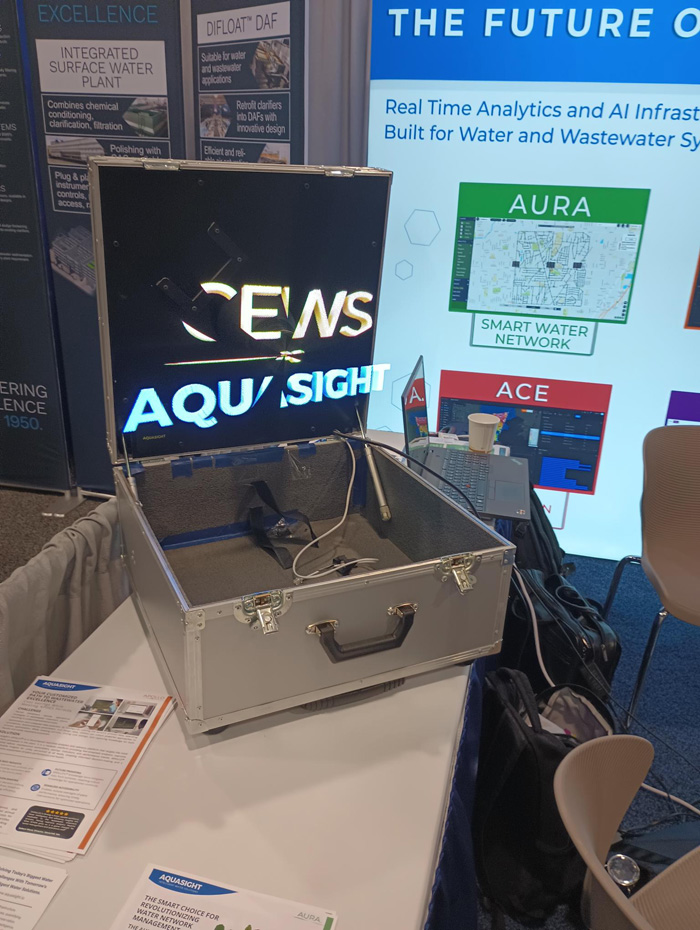
Cool, eh?
Talking to Robert Bouton, I was apprised of Aquasight’s impressive lineup of AI-powered apps, covering… well, most anything: ATLAS for pump health and operation, AURA for smart water distribution system, ACE for collection system intelligence, APOLLO for efficient wastewater treatment, AMP for asset management and capital planning, and CEWS for infectious disease monitoring — like COVID, or bird flu, or whatever comes next (ugh). But even bad information is power. Understanding the problem is key to resolving it, and these digital solutions empower utilities to better serve their communities.
Autodesk was in full force at ACE, and it’s arguable that the company has a leg up on its water-industry peers in terms of recognition and experience; as the water space experiences a digital transformation, Autodesk helped pioneer a digital revolution with the introduction of AutoCAD in 1982. Still in the pioneering game, Autodesk offers a range of solutions for engineers and water managers, including:
- InfoWater Pro to strategically design water networks for optimal and efficient water distribution
- InfoWorks WS Pro to visualize and analyze your networks with advanced hydraulic monitoring
- Info360 Insight, relying on accurate data from IoT devices to monitor your water network in real time
- Info360 Asset, using ‘in-built’ analysis for effective capital planning and extending asset lifespans
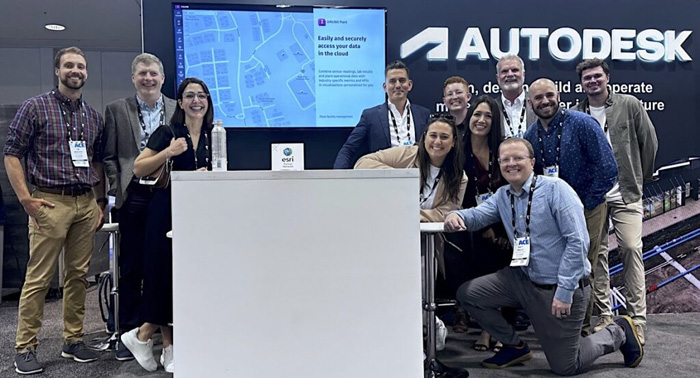
The Autodesk team at ACE24
Improving Water Quality, And How We Manage It
One of my favorite encounters at ACE was the introduction to Fontus Blue and its CEO and founder, Chris Miller. A PhD and PE, Miller is also a Civil Engineering professor (still active, going on 29 years) at the University of Akron. Teacher first, I suspect, but a smart guy whose idea was so good that he became a water entrepreneur. That idea was the Virtual Jar, which is like a digital twin for jar tests — except the simulations are multifold while constantly expanding and improving through AI and machine learning, and completed in about 30 seconds. This allows operators to investigate chemical dosing alternatives and decide the best path to meet water optimization goals. Results are presented through decision support software called Decision Blue, which offers much more in the way of water quality and optimization than discussed here. Learn more.
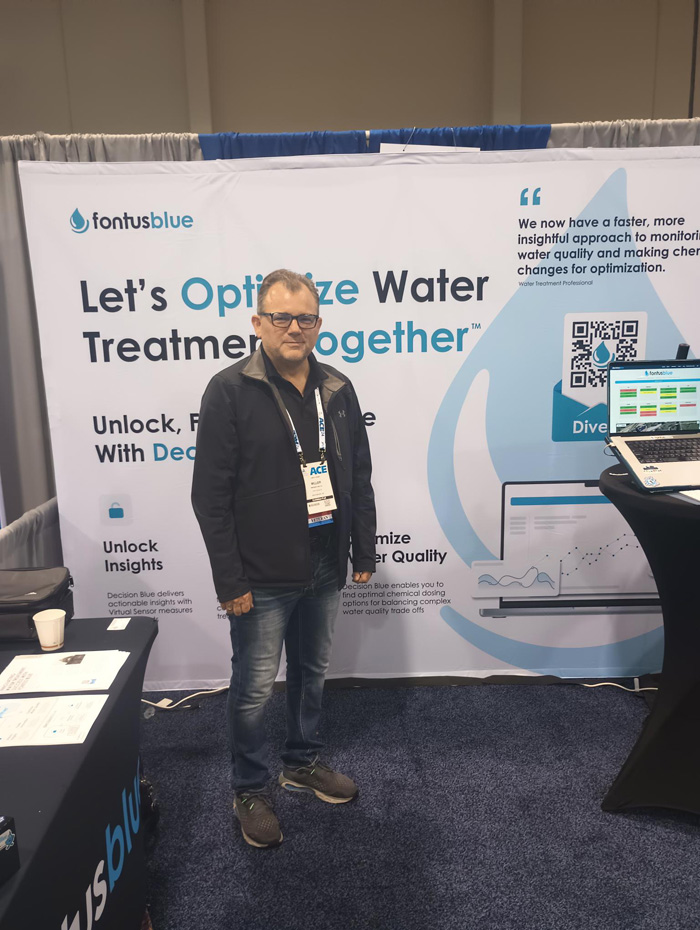
Chris Miller of Fontus Blue
Every utility should strive for great-tasting water, like the City of Charlottetown, winner of the Best of the Best Taste Test at ACE24. If, on the other hand, you have taste, odor, or appearance issues, you may actually have a bacteria issue. The answer could be BactoSense (shown below) from bNovate. Bryan Kimbell, Business Development and Sales Manager, relayed to me that the system is new to the U.S. from Europe (and now getting distribution in Southeast Asia) and completely novel for the ACE show floor. It works by analyzing water conditions 24/7, anywhere in the cycle, including the distribution network, and red-flags potentially problematic bacterial growth. More technically stated, it provides automated online flow cytometry solutions for microbiological analysis. Simply stated, it enables better-tasting water.
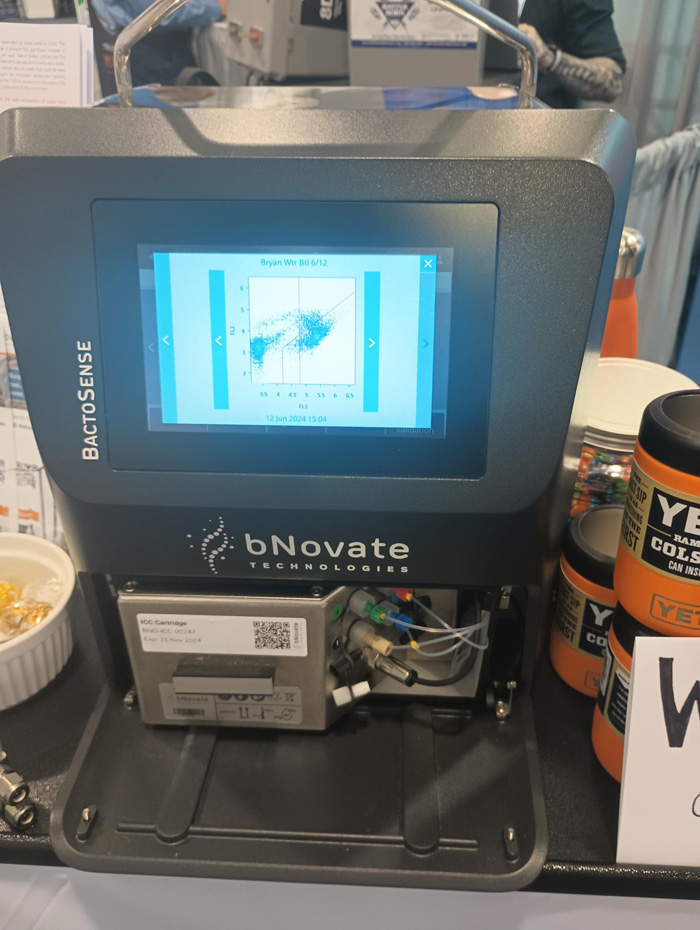
BactoSense displaying bacterial count results
What About The Humans?
With all this talk about machines, artificial intelligence, etc., let’s not forget about the men and women who are in the field doing the work. But, this is an article about digital technologies, so… let’s converge the two.
You likely know how digital twins can model system capabilities and potentialities without actually building the thing, but you also probably think that this timesaving and problem-avoiding benefit is reserved for engineers and large infrastructure projects. That’s mostly true, and it’s also true that the data entry and results can take weeks or months. Qatium, however, has put digital twin capabilities (literally) in the hands of operators — and on desktops — to optimize regular procedures like:
- Watermain shutdowns – Confirm the right valves to isolate to see how it affects customers.
- Tank management – Quickly identify tank-level anomalies in your networks with warnings and notifications.
- Flushing sequences – Design efficient flushing sequences to minimize disturbance and ensure clean water.
- Managing demand and fire flows – Induce high flow rates to ensure service and fire protection.
- Pressure rezoning – Preview the impact of new district metered areas. Ensure customers keep optimal pressure by evaluating boundaries.
- Survey your network – Build your own control room, using your model as a live data source.
And much more, managed anywhere through apps that can be viewed anywhere. It’s the everyday digital twin that can be built in days, based on data from GIS, SCADA, sensors, smart meters, and other systems that you already have in place.
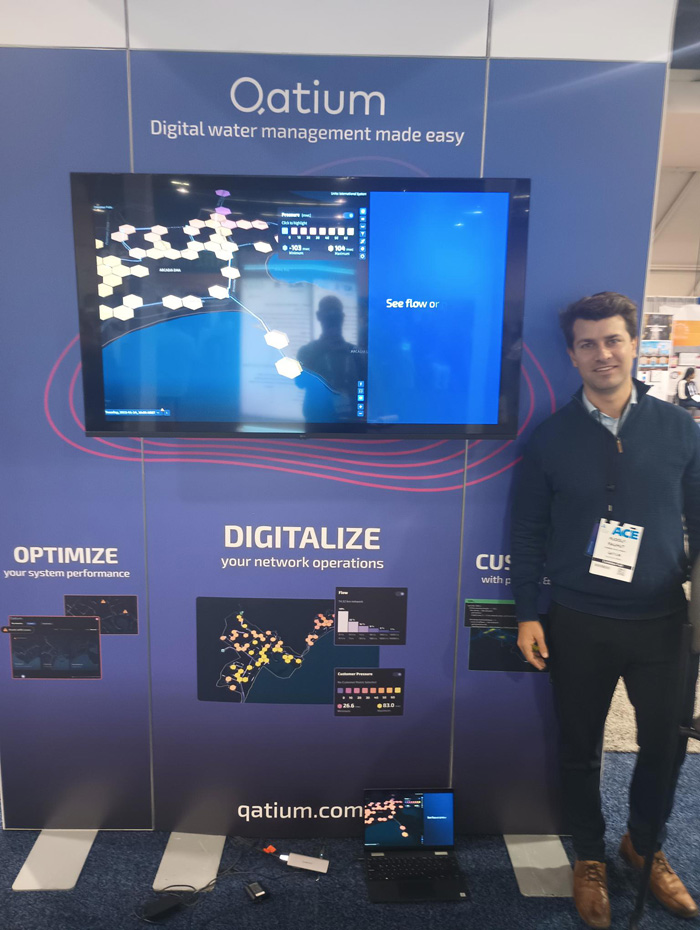
Rudolf Rauhut, Business Development (and a bald editor’s reflection)
Work orders, amiright? Cumbersome, frustrating, sometimes messy, but also important to workflow and labor management (if carried out dutifully and accurately). With KloudGin, the entire process is streamlined, easy, and clean, thus work — and labor management — gets done more efficiently. A single view, available on phone, iPad, or wherever, connects customers, employees, and assets to complete information with AI-powered access. Built in the cloud, it offers a unified, holistic view of maintenance and service operations for your water and/or wastewater network — a “Single Face of Work” says their motto — to improve asset utilization, workforce productivity, customer experience, resilience, and regulatory compliance. Just some of the multitude of tasks it enhances and simplifies are:
- DigAlert (811 call)
- AMI/AMR install and repairs
- Backflow prevention and cross connection
- Leak management
- Predictive maintenance
- Water quality and discharge monitoring
...and, ending where we began this digital journey:
Thanks for taking the journey with me. I hope you found something helpful.
